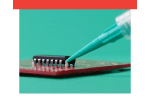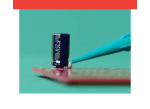See how to properly apply a staking compound to an electronic component for enhanced mechanical reinforcement. Learn how to apply the material on components of differing sizes and shapes as well as what material works best for this type of application.
![]() DOWNLOAD NOW
DOWNLOAD NOW
Download our printable guide on applying a staking compound to secure electronic components
How Do You Use a Staking Compound on a Circuit Board?
The main use for adhesive staking is to provide extra mechanical support for electronic components and other parts that may be damaged due to vibration, shock or handling. Different components require different methods of staking.
 Staking a Dual In-Line Packaging (DIP) Component
Staking a Dual In-Line Packaging (DIP) Component
A DIP component requires staking at the four corners using a fine tip syringe with a high viscosity compound.
The goal is to connect the corners of the component to the circuit board while ensuring that the material does not flow under the component.
 Staking a Capacitor
Staking a Capacitor
Capacitors often require staking for enhanced stability. In this case, the material is applied to the edge of the component while making mechanical connection with the circuit board.
Note: There are other ways to stake a capacitor including staking at more than one location or even applying the material around the entire component.
 After Applying Staking Compound
After Applying Staking Compound
The material should be cured based on the instructions on the technical data sheet.
 Staking Compound Example: EP17HTDA-1
Staking Compound Example: EP17HTDA-1
One part epoxy system EP17HTDA-1 is a thermally conductive, electrically insulative material featuring a thixotropic paste viscosity. It cures in one to two hours at 350°F with minimal shrinkage.
Disclaimer: Please ensure that the appropriate precautions are exercised in terms of safety, health and feasibility of the techniques included here. Please note that this guide should not to be used for any specification purposes.
